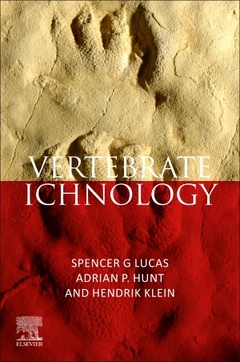Description
Vertebrate Ichnology
The Fossil Record of Prehistoric Behavior
Coordinators: Lucas Spencer G, Hunt P Adrian, Klein Hendrik
Language: English
Subjects for Vertebrate Ichnology:
Keywords
<; P>; Ichnology; trace fossils; behavior; geological time series; footprints; bromalites; burrows; evolutionary events; Earth history<; /P>
370 p. · 15x22.8 cm · Paperback
Description
/li>Contents
/li>Biography
/li>Comment
/li>
Vertebrate Ichnology: The Fossil Record of Prehistoric Behavior is a complete review and analysis of vertebrate trace fossils, including how vertebrate trace fossils inform our understanding of major evolutionary events. It covers all aspects of the vertebrate trace fossil record including tetrapod footprints, fish traces and other trails, burrows, nests and more. Each record is reviewed by prominent experts with extensive illustrations and can be used as a tool to solve problems of vertebrate biochronology and biogeography. Megabiases in the record are identified, and trace fossils applied to analysis and the understanding of major events in the evolutionary history of vertebrates. This is a useful daily reference for paleontologists and geologists; and teaching professors or other researchers working in trace fossils and related fields, including university and graduate students.
1. Introduction Section 1. The ichnology of locomotion 2. Tetrapods 3. Fish Section 2. The ichnology of consumption 4. Regurgitalites 5. Consumulites 6. Coprolites 7. Gastroliths Section 3. The ichnology of habitation and reproduction 8. Vertebrate burrows 9. Nests 10. Ichnology of reproduction (e.g., tracks showing mating or display) Section 4. Synthesis (analyzes the vertebrate trace fossil record, its strengths and weakness and application to understanding vertebrate evolutionary history) 11. Megabiases in the fossil record of vertebrate traces 12. Ichnofacies 13. Ichnology and biochronology 14. Ichnology and biogeography 15. Traces and major evolutionary events in vertebrate history 16. Prospectus and issues in vertebrate ichnology
Adrian P. Hunt is a palaeontologist who has been Adjunct Curator of Paleontology at New Mexico Museum of Natural History and Science (New Mexico) since 2007 and Executive Director of the Flying Heritage and Combat Armor Museum (Washington) since 2007. Previously, he was founder/curator of the Mesalands Dinosaur Museum (New Mexico) and Executive Director of the New Mexico Museum of Natural History and Science. He is particularly interested in vertebrate trace fossils, ranging from coprolites to footprints, and he has published in this subject area for over 35 years, having published more than 700 articles, and written or edited six books.
Hendrik Klein is an independent researcher working at Saurierwelt Paläontologisches Museum, Germany. His main research fields are vertebrate paleontology and ichnology. He is a member of the editorial boards of the New Mexico Museum of Natural History and Science Bulletin and the Ichnos journal. Present research projects and work include Tetrapod ichnology and ichnostratigraphy of the Triassic; ichnology and paleoecology of Paleozoic-Mesozoic strata in Morocco with Technical University, Bergakademie Freiberg, Germany and
- Fully covers all aspects of the vertebrate trace fossil record through review and analysis
- Includes not only footprints, but all other kinds of vertebrate traces, bringing to the forefront relatively understudied vertebrate trace fossils
- Written by the most active and informed experts on vertebrate trace fossils for an up-to-date and authoritative reference




